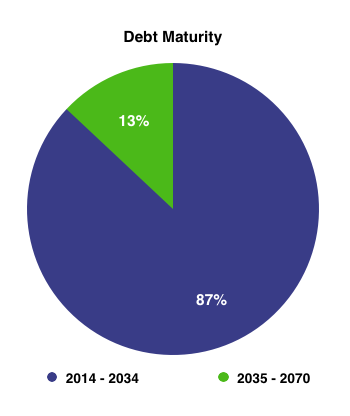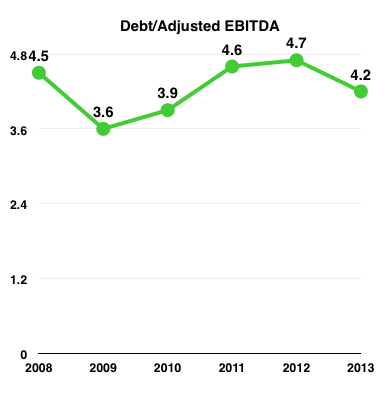The rules of the game for master limited partnerships stipulate paying out almost all of their cash and issuing massive amounts of debt and equity to fund growth. The frequency of debt offerings can be difficult to track, and often entails pouring over long lists of senior notes and maturity dates -- an activity that's sure to make your eyes glaze over at some point.
That's why today we're telling the Buckeye Partners (BPL +0.00%) debt story in three charts instead. As we explore Buckeye's debt, we'll keep things in context by comparing certain statistics to its peers Plains All American Pipeline (PAA +0.90%) and Magellan Midstream Partners (MMP +0.00%).
1. 10-year debt picture
Before we overwhelm ourselves with debt-related computations, we should know exactly what we're dealing with at Buckeye Partners for the next 10 years. The chart below details the partnership's principal and interest payments per year for the next decade.

The blue bars reflect the amount of principal due each year, while the green indicate how much Buckeye will pay in interest on its fixed rate debt. The one thing this chart doesn't capture is the partnership's revolving credit facility, or any floating rate bonds it has issued, because those rates may change.
2. Debt maturity
Evaluating a company's debt maturities can tip you off to a couple of things. First, debt that matures decades from now is more desirable than debt that matures tomorrow. This is especially true right now, when many energy companies are spending big-time dollars bringing major infrastructure projects online. It's better to use debt to grow, rather than to just pay off current liabilities, when possible. The one caveat to this is the impact duration has on interest rates: The longer the maturity, the higher the rate, and the higher the interest payment.
Here's how debt breaks down over time at Buckeye Partners:

Source: Company filings
You can see that at 87%, the vast majority of Buckeye's debt is due in the next 20 years. Magellan Midstream's debt due in the same period is closer to 70%, though the partnership that really stands out here is Enterprise Products Partners (EPD +0.71%), which sports a mere 54% of its debt due by 2034.
Of course, we have to put this all in context before we determine that Buckeye Partners is doomed because it hasn't extended its debt maturities. Our first chart shows that the partnership has no principal due in 2015 or 2016, which means it is not as burdened in the immediate future as our second chart might lead us to believe. Ultimately, what really matters is Buckeye's ability to pay off the debt it has assumed, and for that we turn to our last chart.
3. Debt to adjusted EBITDA
In order to get a sense for Buckeye's ability to generate enough cash to cover its debt, analysts and credit agencies alike turn to the debt-to-adjusted-EBITDA ratio.

Source: Company presentation. 2013's figure is last twelve months, per BPL.
Current debt levels at Buckeye Partners are 4.2 times adjusted EBITDA. Though that number is far higher than at Magellan Midstream or Plains All American -- which are at 3.1 and 3.3 times, respectively -- it is still within the accepted range for an investment-grade rating from Standard & Poor's. The agency prefers the ratio to come in no higher than 4.0 to 4.5 times debt to adjusted EBITDA. While it's certainly fair to be skeptical of the ratings agencies given their role in our most recent financial crisis, these ratings still tie directly to the interest rates on a partnership's debt, increasing the importance of a healthy ratio.
The right balance
An MLP's ideal debt story will feature long-term debt issued at a low interest rate, which allows a partnership to develop its asset footprint to generate cash to pay off debt down the line. Too much debt can ruin a credit rating if your MLP isn't generating enough cash, making capital more expensive and hurting competitiveness in the future. Successful investing in this space is all about finding an MLP that strikes the right balance between issuing enough debt to spur growth and developing projects that will generate enough cash to pay it off.